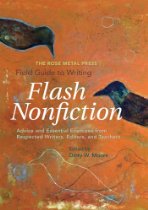The Rose Metal Press Field Guide to Writing Flash Nonfiction
Edited by Dinty Moore
Rose Metal Press
2012
 It is refreshing to open a nonfiction craft book that does not begin with an apology. Editor Dinty Moore delves right into a discussion of what is possible when writing “flash” literary nonfiction, “memoir, essay, and factual writing in the very short form”—750 words or less. The brief history of the short essay is also refreshing—Moore does not inform in order to justify the topic, but to show tradition, variation, and current practice. This literary history and progression is necessary, for Moore quickly moves to current practitioners and editors, so he can work towards a definition that adequately describes flash nonfiction, without imposing limits.
It is refreshing to open a nonfiction craft book that does not begin with an apology. Editor Dinty Moore delves right into a discussion of what is possible when writing “flash” literary nonfiction, “memoir, essay, and factual writing in the very short form”—750 words or less. The brief history of the short essay is also refreshing—Moore does not inform in order to justify the topic, but to show tradition, variation, and current practice. This literary history and progression is necessary, for Moore quickly moves to current practitioners and editors, so he can work towards a definition that adequately describes flash nonfiction, without imposing limits.
This is where Moore ultimately succeeds. He is an effective ambassador for flash nonfiction; as a skilled nonfiction practitioner and the editor of the online journal Brevity, Moore is knowledgeable and passionate about nonfiction as an art form. Subsequently, the anthology rises above a mere “how-to” book; this artistic endeavor is inspirational, cerebral, and practical. Twenty-six authors, editors, and teachers each address a topic or aspect of flash nonfiction in a craft essay, provide a writing prompt based upon that topic, and also include an example essay. This comprehensive exploration nudges the reader in different directions, from the first chapter on size itself—Lia Purpura’s “On Miniatures”—to the last chapter from Jeff Gundy, “Walking, Gathering, Listening,” which urges the reader to gather the details of the world.
In between, each author addresses the reader directly. Rigoberto González, in “Memory Triggers and Tropes,” addresses the issue of inspiration and significance through image, and his prompt begins with “recall a memory. . .” Although this exercise is universally accessible, the work he entreaties the writer to perform is methodical and thorough:
The labor in writing flash nonfiction will not be taxing if the writer has the three necessary ingredients: a memory charged by an emotional experience, an image/object/symbol that inextricably bound to that memory, and an editor’s chisel to chip away at the excess detail, dialogue, and description.
Anyone can participate, but don’t underestimate practice. Of course, due to Moore’s chapter selection and arrangement, practice and diligence are a recurring theme. Jennifer Sinor discusses the link between voice and practice, and notes that “voice takes time. . .comes forth through revision, each draft coming closer to what you really want to say.” Barbara Hurd tackles practice in her exercises after advising readers to copy their favorite writer’s sentences and post them around the house, reading them aloud, “imitating each of their rhythms and structures. Don’t worry about modeling too closely; this is practice not publication.”
Despite the different chapters and multiple topics, this thread of accord, what Moore refers to as “remarkable agreement here on the basic components of the shorter form” winds through the many aspects of flash nonfiction covered in the anthology, including: form, setting, voice, structure, language, image, and detail. A reader can tackle these in order, or dive in according to whim or mood. Each chapter differs in voice, subject, and focus while creating a cohesive and satisfying whole.
For the example essays, some authors include their own work, while others select essays from other writers, which expands the already numerous voices in the conversation. And Maggie McKnight’s graphic essay pushes boundaries to reveal other formal possibilities for framing a story. If you still hunger for more, the short “Further Reading” list includes the Judith Kitchen anthologies Moore refers to in the introduction, as well as single-author collections of flash nonfiction and individual essays.
Useful? Yes. Engaging and inspiring? Certainly. Not just entertaining inside, the cover is also bright and inviting—my review copy is electronic, which functions nicely, but I look forward to owning my own hard copy. This guide is perfect for an individual, for writing groups, or in a classroom. A deserving companion to the Rose Metal Press Field Guide to Prose Poetry, and Field Guide to Flash Fiction, Editors Abigail Beckel and Kathleen Rooney have indeed created “a trifecta of craft study of hybrid forms.”

Comments on this entry are closed.
Sounds like a keeper, especially for a teacher!